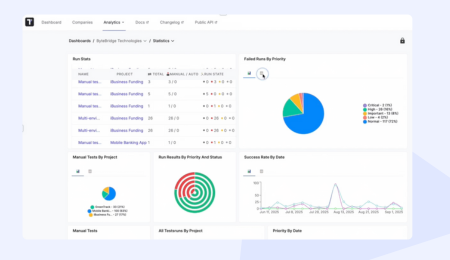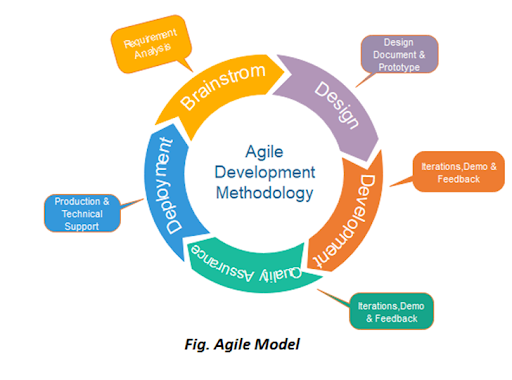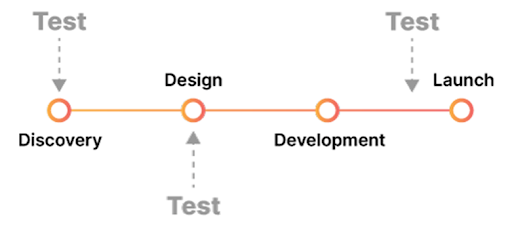Integrating Quality Assurance into an agile development process can be very complex as well as difficult. To match the swagger of an ever-expanding market, numerous organizations are transitioning to an agile manner for planning and management.
What separates the Agile advance from other methods of working, as example the Waterfall model?
Agile is defined by collaboration, iteration, and speedy and repeatable delivery schedules. Implementing these new business processes can be difficult at first, so in this blog, we will share some helpful tips on how to integrate your QA team with your agile development teams and get results fast. With the right strategies and approach, it is possible to ensure that quality assurance is a smooth and efficient part of your Agile Workflow.
What is Agile Development Process?
The Agile development process is a way of working that is designed to improve the speed, flexibility and reliability of software development. It was developed in response to the problems that often occur with traditional software development methods.
The Agile development process is designed to ensure customer satisfaction, continuous feedback, and responding to change. It also emphasizes the importance of close collaboration between developers and customers, and the need for constant communication and feedback throughout the development process.
What is a Sprint?
In the Agile development process, teams of developers work together to create small, working pieces of software called “sprints.” Each sprint lasts about four weeks, and during each one, the team members work together to create a new piece of software. Once the sprint is complete, the team tests the software and makes sure it works properly. After that, they continue to work on the software, refining it as they go.
What does an agile methodology include?
The Agile methodologies include Scrum, Kanban, and XP. These methodologies all have different practices, but they all share the core principles of Agile development: collaboration, flexibility, and continuous improvement.
Tips and strategies to integrate QA into Agile development processes
👉 Start with a clear understanding of Agile and QA principles
Agile and QA are important concepts in software development. Understanding their roles in the process can help you create a successful strategy for incorporating QA into your Agile development process.
What are Agile Principles?
- The principles of agile development are designed to ensure that the people who use the software receive it as soon as possible and that it is of high quality.
- Changes in requirements are accepted and carried out quickly, while the goal is to deliver working software often – usually within a shorter time-frame.
- Close collaboration and communication between the development team and other stakeholders is essential, as is a commitment to quality and simplicity.
- Teams are self-organizing and able to adapt as the situation changes.
- Regular reflection on the agile development process is encouraged.
What are QA Principles?
- The customer or business stakeholder specifies the requirements for the software. This ensures that the software meets their specific needs.
- We use testing to check the software throughout its development process, looking for any defects that need to be fixed right away.
- We make sure that the software we produce is reliable, maintainable, and meets the required quality standard.
- Identifying and mitigating risks to software quality and reliability
- Providing feedback to developers to help them improve the quality of their work.
By following these principles, you can develop a plan for integrating QA into your Agile development process. This plan might involve creating a QA plan that is aligned with Agile principles, establishing effective communication and collaboration between QA and development teams, and using Agile practices such as continuous integration and automated testing to support QA efforts.
Integrating a Quality Assurance (QA) into our Agile methodology process was crucial as it ensured continuous improvement and high quality in software development. It allowed for early detection and correction of defects, reducing the overall cost and time needed for fixes. Moreover, incorporating QA in Agile fostered a collaborative environment where developers and testers work together, leading to better understanding of requirements and higher customer satisfaction.
Andrew Stetsenko from Relocate.me
Involve QA in the development process from the outset
QA should be involved in the development process from the beginning so that the quality of the product is always high. This will help to identify and address potential issues early on, so that there is less chance of having to fix problems later on in the development process.
What are different ways to involve QA from the beginning?
- Include QA in project planning: During the project initiation phase, the QA should be involved all times. This will help in identifying any potential risks, outline the testing requirements, and define the quality goals.
- Increased collaboration between QA and development teams: The QA and dev teams should have close collaboration to create a quality product. The communication between both has to be precise and regular. They should work together and have same understanding on testing requirements
- Create a testing plan: A testing plan should be made that outlines the features to be tested, types of testing that will be performed, and the tools and techniques that will be used
- Establish a process for reporting and tracking defects: a process for reporting and tracking defects should be set early on so that QA and development teams can work together to fix them. There shall be clear guidelines to define who will set priorities for defects and how will they get resolved.
By involving QA from the project onset, you can ensure that the quality of the development process is high, and that QA is integrated into the Agile development process effectively.
Develop a QA plan that aligns with Agile development
Your QA plan should be designed to work with the Agile development process, which means that you will get feedback quickly and make improvements constantly. This way, QA will be integrated into the development process rather than being an afterthought.
Developing a QA plan that aligns with Agile development requires a different approach compared to traditional development. Here are some steps to consider:
- Understand the Agile development process: Before creating a QA plan that is aligned with the Agile development process, you need to understand the Agile development process and its principles, such as continuous integration, collaboration, and flexibility.
- Identify the testing requirements: The testing requirements should be adaptable, and testing should be carried out throughout the development cycle.
- Determine the types of testing: In agile development, we focus on testing early and often to make sure that the software meets the requirements and specifications that our customers or business stakeholders have set. This might include performing Functional Testing, Regression Testing, Acceptance Testing, and Exploratory Testing.
- Define the testing approach: Agile development involves testing throughout the development process, and this helps ensure that the software is of the highest quality.
- Determine the testing tools and techniques: The testing tools and techniques that will be used to ensure that the testing is done efficiently and effectively include automated testing tools, performance testing tools, and exploratory testing techniques.
- Define the testing metrics: In order to improve the quality of the software development process, agile teams constantly need to reflect on their work and make adjustments as needed. They may use testing metrics to measure how well the software is doing and how much time it is taking to fix defects.
- Plan for continuous improvement: The Agile development process is based on the principle of continuous improvement. Every time there are new changes to the software, the team members will review their testing plan and make any necessary changes. This helps ensure that the software is as reliable as possible.
By creating a quality assurance plan that is in line with Agile development, you can ensure that quality is integrated into the development process from the start, and that testing is efficient, effective, and flexible.
Automate testing wherever possible
Automation can help speed up the testing process and ensure that tests are done consistently and accurately. This can help reduce the time and effort required for testing, allowing QA to keep up with the fast pace of Agile development.
Automating testing wherever possible is a critical aspect of integrating QA into Agile development processes. Here are some tips for automating testing effectively:
- Identify areas for automation: There are some testing processes that can be automated, such as regression testing, load testing, and integration testing. These are processes where the same tests are repeated regularly, so they can be done more easily and quickly by a computer.
- Choose the right automation tools: To get the most out of automation, choose the right tool for the job. There are many automation tools available, like Selenium, Appium, and JUnit, among others. These tools can help you test and automate web applications.
- Develop automated tests early: By testing your software as you develop it, you’ll be able to catch any problems before they become too big to fix. This will help you keep your software running smoothly and avoid any embarrassing defects.
- Keep automated tests up-to-date: As the software develops, the automated tests must also change to keep up. Keep the automated tests updated so that they can continue to find defects in the software.
- Integrate automated testing into the development process: Automated testing is a way of making sure that your software is working as it should, and that defects are quickly identified and corrected. You can use continuous integration tools, such as Jenkins or Travis CI, to do this automatically. This way, you can keep your development process running smoothly and ensure that your software is always bug-free.
- Use metrics to measure the effectiveness of automated testing: Automated testing is a way to check how well a program works by running it automatically. Metrics can help you measure how effective the testing was.
By automating your testing process, you can make sure that the testing is done efficiently and that defects are identified and corrected as quickly as possible. This will help to ensure that the software meets the required level of quality and is delivered on time and within budget.
Use metrics to track progress and identify areas for improvement
Metrics can help you track how well the QA process is working. Here are some tips on how to use metrics to improve the QA process:
- Focus on meaningful metrics: Identify metrics that are meaningful to the development team and that align with the goals of the project. For example, tracking the number of defects found and fixed might be more meaningful than tracking the number of lines of code written.
- Use metrics to identify areas for improvement: Regularly analyzing your QA process can help you identify where improvements can be made. For example, if a particular type of defect is being found frequently, it may be worth looking into changing your testing strategy.
- Set goals and targets: You can set goals for how well the team is doing in terms of quality assurance (QA). This will help to ensure that the team is always making progress and getting better at testing products.
- Communicate metrics effectively: Metrics help you to track the progress of a project and make sure that everyone is working together towards the same goals.
- Use metrics for root cause analysis: Metrics can help identify the cause of defects. For example, if a particular module is causing a lot of defects, it may be necessary to look at the design of that module.
By using metrics to measure and track progress, you can ensure that the quality assurance process always improves and that the software is of the highest possible quality. This information can help you identify areas for improvement, set goals and targets, and provide valuable insights into the development process.
Foster collaboration between development and QA teams
Collaboration between development and QA teams is important so that QA is integrated effectively into the Agile development process. This can be done through regular communication and collaboration. It ensures everyone is working towards a common goal.
- Start with clear communication: Developing and QA teams need to be able to communicate clearly to make sure the project goals are met. They should meet regularly to share information and ensure everyone is on the same page.
- Involve QA early in the development process: Involve QA early in the development process to ensure that QA requirements are considered from the outset. This will help to prevent issues from arising later in the development process and will ensure that the software is developed with QA in mind.
- Collaborate on test planning: To make sure that the testing process is complete and covers all of the important areas of the software, work together to plan the tests. This will help to ensure that the tests are thorough and cover all of the important aspects of the software.
- Use a shared test management tool: By using a shared testing tool, both development and QA teams can easily keep track of the status of testing. This way, everyone is always aware of what needs to be done next to ensure the product is as bug-free as possible.
- Promote cross-functional training: Cross-functional training can help to ensure that both development and QA teams have a basic understanding of each other’s roles and responsibilities. This will help to promote mutual understanding and cooperation.
- Celebrate successes together: To celebrate successes together is a way to promote teamwork and collaboration. This will help create a positive work environment and encourage both teams to keep working together well.
By working together, you can make sure that the software is of the highest quality and that development is done efficiently. Communicating clearly, involving yourselves early, using shared test management tools, cross-functional training, and celebrating successes are all important ways to help make collaboration between QA and development successful.
Emphasize the importance of quality throughout the organization
Everyone in the organization should make quality their top priority. This will help to ensure that the organization produces high-quality products and that quality is a part of every step of the development process.
It is important to have quality control throughout the development process in order to produce high-quality software that meets the needs of users and stakeholders. A culture of quality should be fostered throughout the organization, where everyone is responsible for ensuring that quality standards are met. This means promoting awareness of quality, involving everyone in the quality process, and using metrics to track quality. By emphasizing the importance of quality, organizations can ensure that they deliver software that meets the highest standards and that satisfies their customers’ needs.
Conclusion
QA is important for developing high-quality software. QA should be involved from the start, testing should be automated where possible, and progress should be tracked and improved with metrics. By working together, all involved parties can make sure that the software is of the highest quality and meets the needs of customers.











